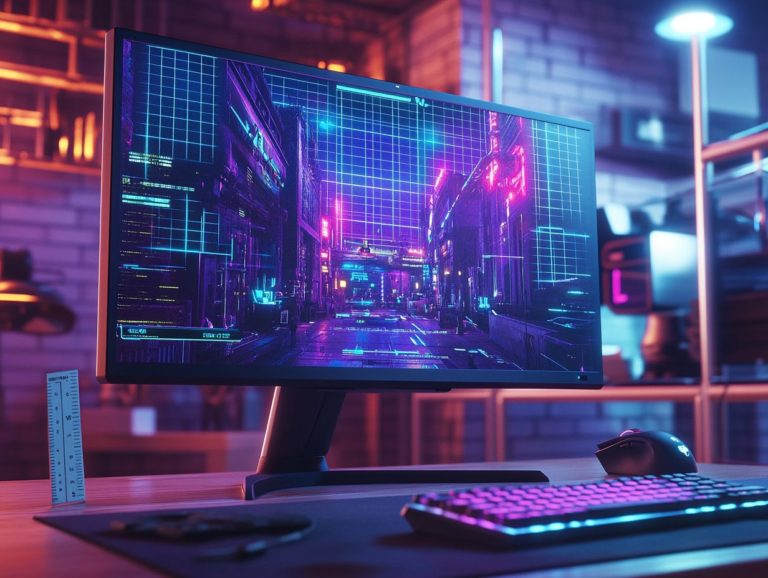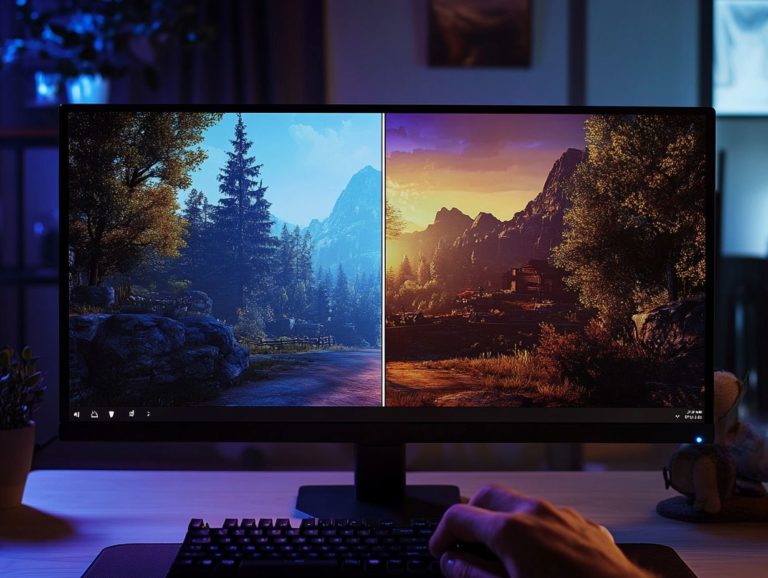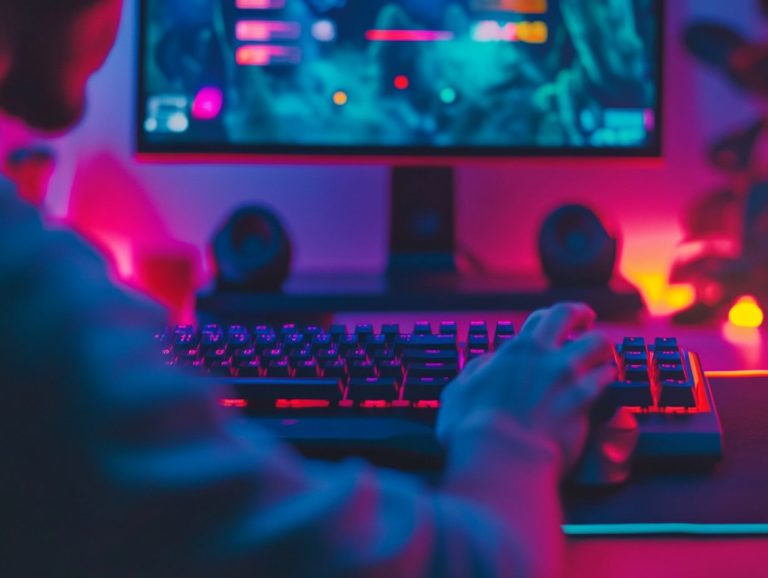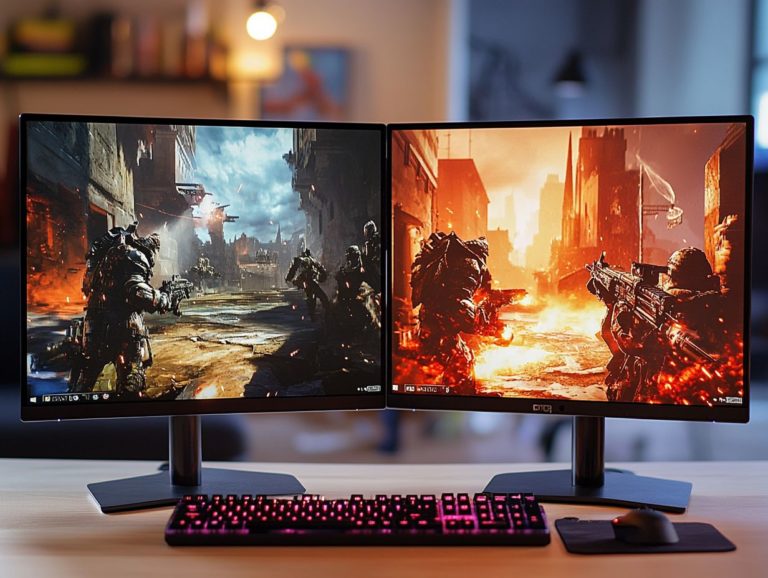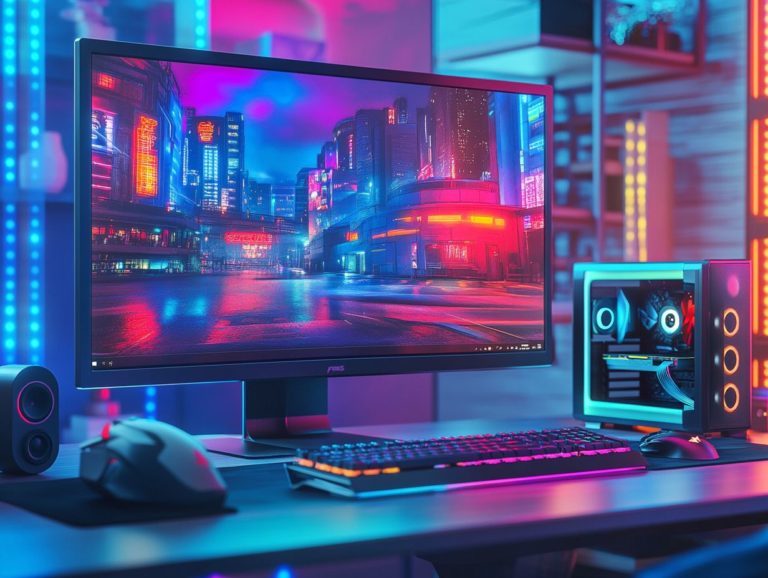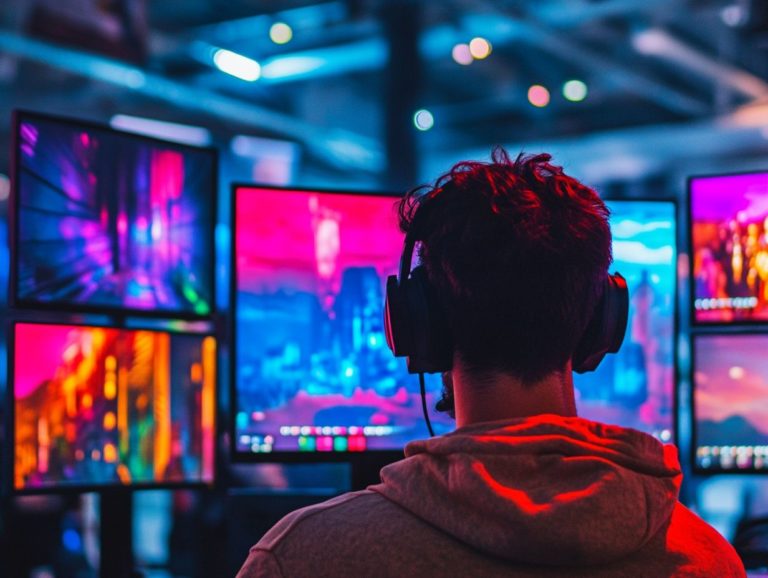the best monitors for game design work
Choosing the right monitor for your game design work is vital to achieving your design goals.
With many options available to you, grasping which features truly matter can significantly impact your workflow.
This guide will illuminate essential characteristics, explore various types of monitors, and offer tips to sidestep common pitfalls. It will empower you to make an informed decision for your game design setup.
Contents
- Key Takeaways:
- 1. High Resolution and Color Accuracy
- 2. Large Screen Size
- 3. Wide Viewing Angle
- 4. Quick Response Time
- 5. Multiple Connectivity Options
- 6. Ergonomic Design
- 7. Compatibility with Design Software
- 8. Budget-Friendly Options
- 9. Monitor Calibration Features
- 10. Dual Monitor Setup
- 11. Energy Efficiency
- 12. Brand Reputation
- 13. Customer Reviews
- 14. Warranty and Support
- 15. Comparison of Top Monitors for Game Design Work
- Why a Great Monitor is Essential for Game Design
- Frequently Asked Questions
- What Are the Must-Have Features of the Best Monitors for Game Design Work?
- Are There Any Specific Brands That Are Known for Producing the Best Monitors for Game Design Work?
- How Important Is Color Accuracy for Game Design Work and How Can I Ensure the Monitor Has It?
- Should I Prioritize a Larger Size or a Higher Resolution When Choosing the Best Monitor for Game Design Work?
- Can I Use a Regular Monitor for Game Design Work or Do I Need a Specific Type?
- Is It Worth Investing in a Curved Monitor for Game Design Work?
Key Takeaways:
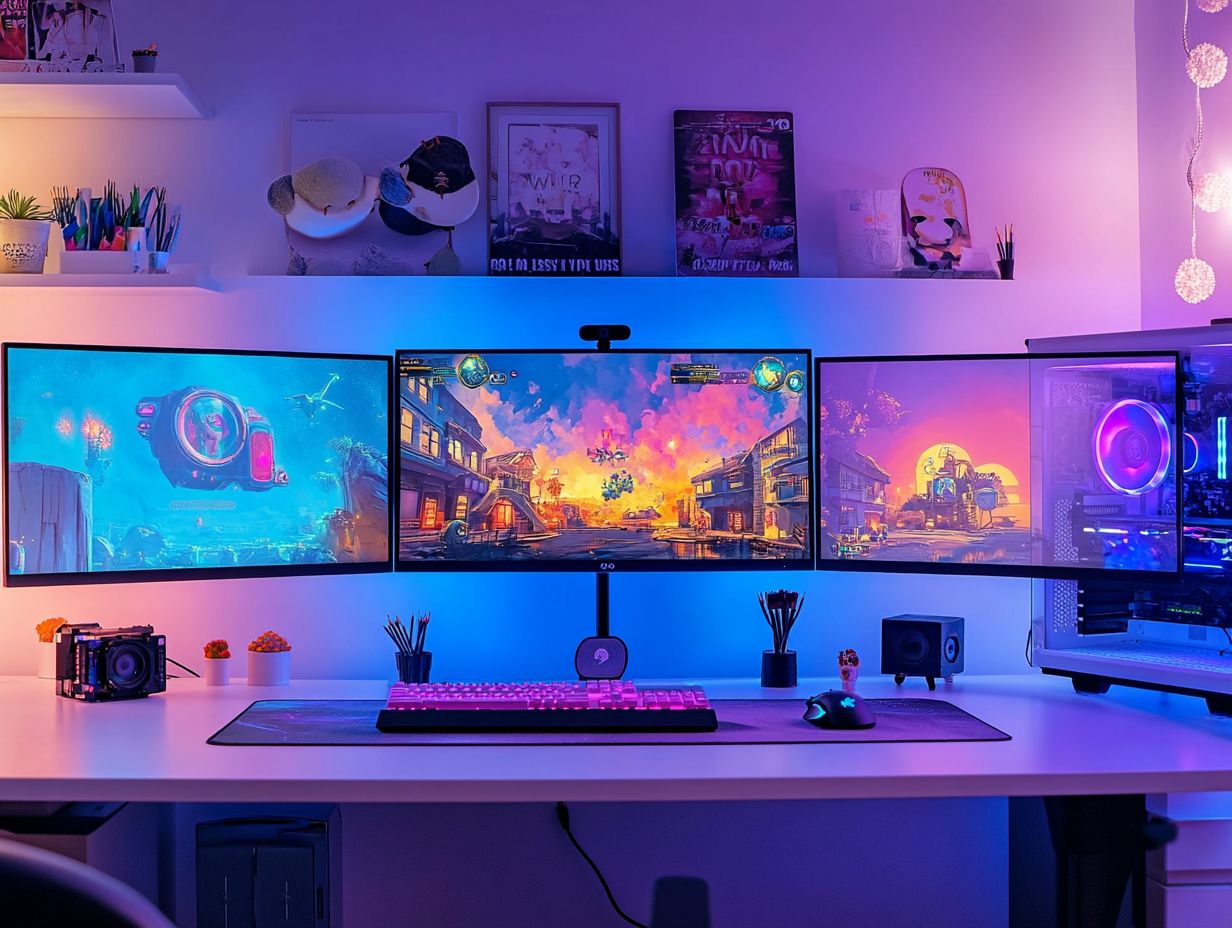
High resolution and color accuracy are crucial. A large screen size gives you more workspace and better visualization.
A wide viewing angle ensures consistent color and image quality from all angles, making it easier to collaborate with others.
1. High Resolution and Color Accuracy
High resolution and color accuracy are paramount in monitors, especially for professionals like you who rely on precise visual representation to bring your creative visions to life.
This is why monitors such as the LG 34GK950F-B and Dell U4919DW are highly coveted in the market. In your world, every detail counts; even the slightest color misrepresentation can lead to significant discrepancies in your work.
High-resolution displays, especially those boasting 4K capabilities, provide sharp, detailed images that enhance visual communication.
Calibration tools, which adjust your monitor to ensure colors are displayed accurately, like the Spyder Elite 5 and EIZO monitor test, are essential in ensuring that your monitors perform at their best.
By accurately calibrating color outputs with these tools, you maintain the integrity of hues and shades, crucial in graphic design and motion graphics.
Monitors like the NEC EA271Q-BK and BenQ PD3220U, when paired with such calibration tools, enable you to create visually stunning work that truly resonates with your audience.
2. Large Screen Size
A large screen size can significantly boost your productivity by offering ample screen real estate. This extra space allows you to multitask efficiently and manage complex user interfaces.
Models like the LG U4919DW or Dell U3223QE are perfect for both designers and developers.
With the expansive visuals these displays provide, you can work seamlessly on intricate designs while keeping your tool palettes and reference materials visible at all times. Say goodbye to the frustration of constant window switching.
For gamers, a larger canvas means heightened immersion and responsiveness. It displays rich detail and allows for better situational awareness.
Applications like Adobe Photoshop and Autodesk Maya thrive in this extra space, making your workflows more intuitive. Wider screens also improve gaming experiences, offering a panoramic view that enhances both gameplay dynamics and strategy.
3. Wide Viewing Angle
A wide viewing angle is essential for your monitors, ensuring that color accuracy remains consistent. This feature allows multiple users to gather around the screen without experiencing distortion.
This is especially advantageous in collaborative environments when using LG or NEC displays.
For designers and artists, this precision in color representation is vital when showcasing their work. Take, for example, monitors from brands like ViewSonic, which boast impressive wide viewing angles often exceeding 178 degrees.
This capability helps maintain visual integrity from various perspectives. On the other hand, LG’s UltraWide displays come with advanced IPS technology, which stands for In-Plane Switching and provides better color accuracy and viewing angles.
These differences enable you as a creative professional to present your projects effectively, ensuring that clients and team members experience the intended visual impact without any compromises.
Start exploring your options today to find the perfect monitor!
4. Quick Response Time
Quick response time is an essential feature in gaming monitors. It allows you to immerse yourself in fast-paced action without the frustration of blurring or ghosting.
This clarity is crucial, especially if you’re using advanced technologies like G-Sync and FreeSync to enhance your gaming experience. Experience lightning-fast gameplay with monitors like the ASUS ROG Swift PG259QN and Dell Alienware AW2521H.
These models boast refresh rates of 360Hz and 240Hz, setting the standard for competitive gaming. Monitors with low response times deliver fluid visuals, enabling you to react with precision to in-game events.
Ultimately, choosing the right monitor can elevate your gaming and design pursuits, providing an immersive and top-notch experience.
5. Multiple Connectivity Options
Modern monitors must have multiple connectivity options. HDMI, DisplayPort, and USB ports allow you to connect various devices easily.
This versatility is beneficial for users of LG and Dell displays. A range of ports lets you connect your laptop, gaming console, and other peripherals, enhancing your efficiency.
For instance, the LG UltraGear series and Dell UltraSharp monitors offer stunning high-resolution displays alongside multiple connection types. This compatibility enables you to work with various software without interruptions.
Switching effortlessly between systems ensures you maximize your creativity and performance without the hassle of constant reconfiguration.
6. Ergonomic Design
An ergonomic design is vital for comfort. Adjustable height, tilt, and swivel features help you work comfortably, especially during long tasks.
With the right setup, you can significantly reduce discomfort and prevent musculoskeletal issues from extended screen time. Features like blue light filters and anti-glare coatings enhance your experience by minimizing eye strain.
Adjustable stands in the Dell UltraSharp series or the BenQ PD line allow you to customize your viewing angles for maximum comfort.
You’ll also appreciate built-in cable management systems, keeping your workspace tidy and organized. This way, you can maintain a seamless focus on productivity without distractions.
7. Compatibility with Design Software
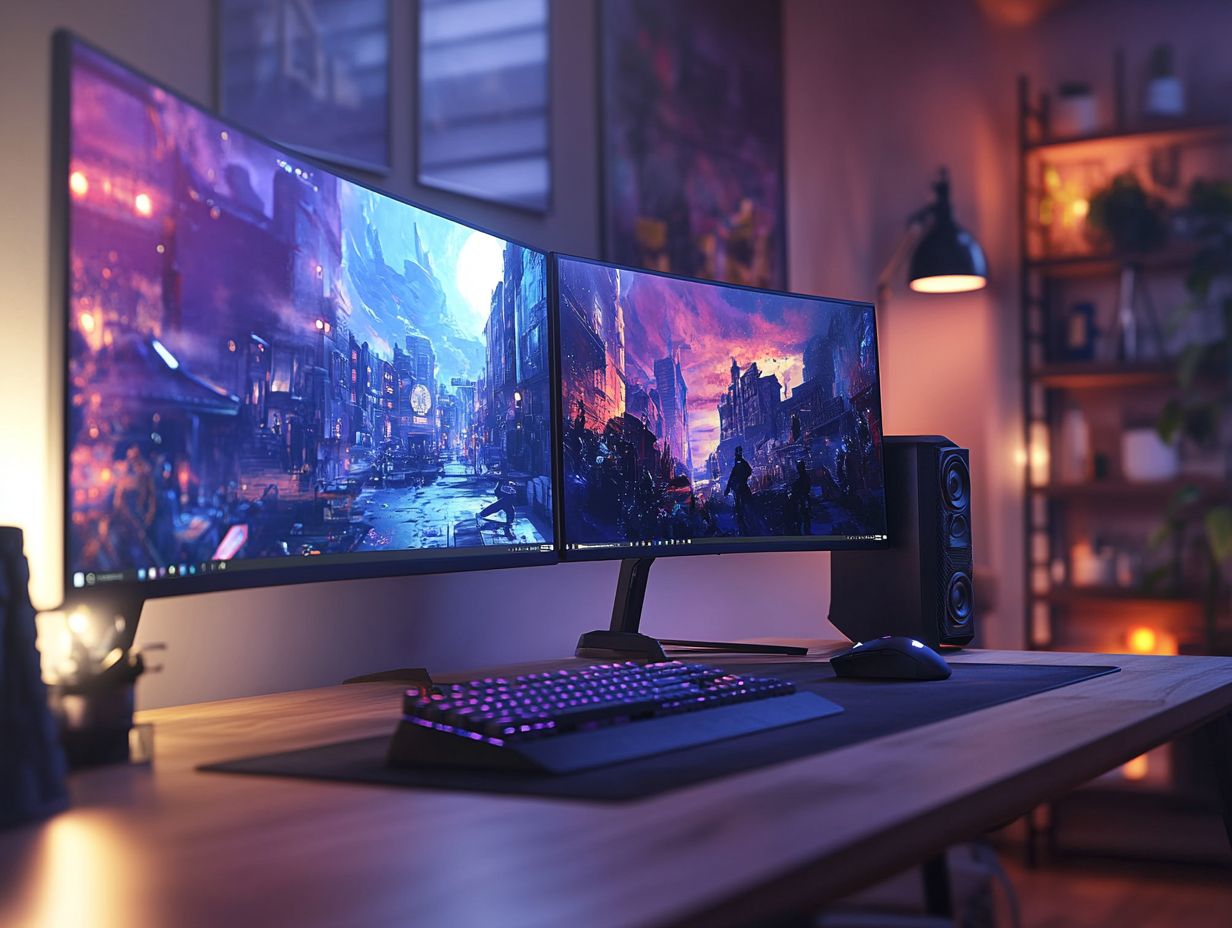
Compatibility with design software like Cinema 4D is essential. Monitors with excellent color accuracy from brands like LG, Dell, and BenQ can elevate your visual workflows, especially if you’re considering the best monitors for gaming.
This level of precision in color representation allows you to trust what appears on your screen, resulting in outputs that are both accurate and vibrant. High-resolution displays provide sharper images, enabling you to focus on intricate details essential for any design project.
When immersed in tasks demanding meticulous attention to visual elements, having a monitor that meets these specifications enhances your efficiency and sparks creativity. For those looking to elevate their gaming experience, the top 5 monitors for competitive gaming can profoundly transform your overall design experience.
8. Budget-Friendly Options
If you’re working with a tight budget, you’ll be pleased to know that several monitors, including the top monitors for esports enthusiasts, deliver exceptional performance without breaking the bank. Brands like LG, Dell, ViewSonic, and NEC are accessible options for 3D artists and motion designers that maintain high quality.
With your focus on resolution, color accuracy, and connectivity, you can effectively narrow down your choices. Aim for monitors that offer at least Full HD resolution and vibrant color reproduction these features are essential for any design work.
Take a look at the Dell P2419H; it boasts an impressive IPS panel, a type of screen technology that offers better color and viewing angles, delivering outstanding performance all at a wallet-friendly price.
The ViewSonic VG2455 is another excellent option, providing crisp visuals and versatile USB-C connectivity, which is a versatile connection type that allows you to connect multiple devices easily. This is perfect for those who need to connect multiple devices.
By honing in on these key aspects, you’ll find that discovering a quality monitor within your budget is not just a dream it’s entirely achievable.
9. Monitor Calibration Features
Monitor calibration features are essential for ensuring color accuracy, and tools like the Spyder Elite 5 and EIZO monitor test enable you to achieve precise results in your work.
These calibration tools aren t just optional extras; they are integral to the visual arts and design realms, where accuracy is non-negotiable. By regularly fine-tuning settings like brightness, contrast, and color balance, you ensure your monitor displays colors just as you intended, making your work shine!
This attention to detail is especially crucial for graphic designers and photographers who depend on consistent and reliable color representation to make informed decisions.
Different monitors come with varying levels of calibration support some boast built-in capabilities that streamline the process, while others may necessitate external tools for optimal performance. No matter your setup, maintaining color accuracy is paramount; even minor discrepancies can lead to significant differences in your final output.
10. Dual Monitor Setup
A dual monitor setup can significantly elevate your productivity, providing you with ample screen real estate that allows for seamless multitasking especially when you choose top-tier brands like LG, Dell, and NEC, renowned for their exceptional display quality.
This configuration proves particularly advantageous for those involved in design and gaming. It lets you effortlessly spread your applications across multiple screens, enhancing your workflow. Whether you’re navigating complex design software or seeking to elevate your gaming experience, having two monitors streamlines user interface management, making it easy to reference materials or chat with friends without interrupting your gameplay.
If you’re considering setting up your own dual monitor system, here are some practical tips to keep in mind:
- Ensure that your monitors are of similar height for optimal comfort.
- Utilize monitor arms to add flexibility to your setup.
- Adjust your settings to optimize display alignment and color calibration, ensuring consistent visuals that are easy on the eyes.
11. Energy Efficiency
Energy efficiency is becoming an essential consideration for your monitors, especially with eco-friendly options available from reputable brands like LG, Dell, and NEC. These monitors not only help you save on electricity bills but also minimize your environmental impact.
Designed to reduce energy consumption without compromising performance, these models are perfect for both home and office environments. Take the LG 27UK850; it comes with features that allow you to cut down on power usage while still enjoying striking display quality.
Dell’s UltraSharp series comes with Energy Star certification, so you can indulge in advanced technology without the worry of skyrocketing utility costs.
By opting for energy-efficient monitors, you’re not just investing in your own savings; you’re also contributing meaningfully to reducing the broader carbon footprint linked to electronic waste and energy consumption. Make the switch to energy-efficient monitors today and watch both your productivity and savings grow!
12. Brand Reputation
Brand reputation is crucial when selecting a monitor. Established names like LG, Dell, ViewSonic, NEC, and BenQ are consistently recognized for their reliability and commitment to quality in performance and customer satisfaction.
These renowned manufacturers have a strong history of meeting consumer expectations. They offer a diverse range of products and steadfast support. When weighing your options, it s natural to gravitate toward brands that carry a trusted name and boast positive customer feedback.
Testimonials and ratings can significantly influence your purchasing decisions. A strong brand reputation reassures you that you’re making a wise investment, effectively reducing the perceived risk of embracing new technologies.
In today s competitive tech landscape, the synergy of brand trust and user endorsements often tips the scales in favor of these established names. This guidance leads you toward a more informed choice.
13. Customer Reviews
Customer reviews are an invaluable resource when selecting monitors. They provide insights into performance, reliability, and overall satisfaction for brands like LG, Dell, and NEC. This information helps you make informed decisions.
Reviews offer a window into real-world experiences. You can assess how specific features such as color accuracy, refresh rates (how often the image on the screen is updated), and connectivity options perform in everyday use. Feedback from current users highlights long-term performance and durability, critical factors for anyone investing in technology.
By exploring how different monitors perform across various settings be it gaming, professional design, or general use you can gain a clearer understanding of which model best suits your unique needs. This insight instills confidence in your purchasing choices.
14. Warranty and Support

When selecting a monitor, warranty and support are vital to your decision-making process! Brands like LG, Dell, and NEC excel in these areas, offering comprehensive customer service and reliable warranties that provide peace of mind.
These policies often include extended warranty options that enhance the longevity and performance reliability of your device.
For example, LG provides a three-year warranty on many of its monitors, covering both parts and labor. This ensures that any potential issues are addressed promptly.
Dell enhances the experience with premium support services, giving you 24/7 access to technical assistance and an advanced exchange service for swift replacements when needed.
NEC stands out with their commitment to long-term reliability, offering a five-year warranty on select models. This speaks volumes about their confidence in product durability.
Such robust support systems not only ease concerns about potential defects but also foster a trust-based relationship between you and the manufacturer.
15. Comparison of Top Monitors for Game Design Work
A comprehensive comparison of top monitors for game design work is essential for professionals seeking the best monitors for simulation games. Models like the LG U4919DW, Dell U3223QE, and NEC EA271Q-BK lead the market with remarkable features and performance.
These monitors offer exceptional resolution and color accuracy. They also cater to varying budgets and requirements, ensuring there s something for everyone.
The LG U4919DW, with its expansive ultrawide display, is perfect for multitasking, allowing you to keep multiple applications open side by side effortlessly.
In contrast, the Dell U3223QE delivers impeccable 4K clarity and superb color reproduction, making it an ideal match for intricate graphics work.
Meanwhile, the NEC EA271Q-BK stands out as a reliable choice for those seeking solid performance without breaking the bank. Numerous user reviews highlight its ergonomic features and consistent output.
Each of these models brings unique qualities to the table, tailored to meet the nuanced demands of game design. This ensures you can produce your best work with confidence.
Explore these monitors today and elevate your game design experience!
Why a Great Monitor is Essential for Game Design
Game design is a complex task, and having one of the top monitors for puzzle games is essential for reflecting the nuances of visual elements. It ensures color accuracy and achieves optimal resolution.
Brands like LG, Dell, and NEC offer displays that are crucial for professionals who aspire to create visually captivating games. The significance of a monitor that meets these technical specifications cannot be overstated; it greatly affects how you perceive and manipulate graphics, shading, and textures.
For example, monitors with a high refresh rate and low response time are crucial for smooth motion handling, especially when animating intricate scenes. Features like HDR (High Dynamic Range) enhance visibility in both shadowy and brightly lit environments, elevating the overall gaming experience.
Choosing the right monitor is a game-changer in your creative journey! It influences not just your workflow but also the ultimate satisfaction of players with the final product.
What Are the Key Features to Look for in a Monitor for Game Design Work?
When you’re selecting a monitor for game design work, it’s essential to consider key features like color accuracy, refresh rate, and compatibility with technologies such as G-Sync and FreeSync. For those interested in gaming, especially RPGs, checking out the best monitors for RPG gaming can also help synchronize the display’s refresh rate with the graphics card, reducing screen tearing.
These features not only elevate the aesthetic appeal of your game but also provide you with a more precise visualization of your creations. For example, a monitor boasting high color accuracy ensures that the vibrant hues and intricate shades in your game graphics are rendered faithfully.
This allows you to fine-tune visual elements with absolute confidence. A higher refresh rate helps minimize motion blur, which is especially beneficial during the testing phase when you re assessing the fluidity of animations.
Adaptive sync technologies also help reduce screen tearing, enabling you to concentrate on perfecting your projects without the nuisance of graphical glitches.
What Are the Different Types of Monitors Available for Game Design Work?
Regarding game design, you have a variety of monitor options at your fingertips, including IPS, TN, and VA panels. Each type has its own unique advantages in terms of color reproduction, response times, and viewing angles.
Understanding these nuances is essential for selecting the perfect monitor tailored to your specific game design needs. IPS panels are renowned for their superior color accuracy and wide viewing angles, making them an excellent choice for artists who demand true-to-life visuals.
On the other hand, TN panels excel in response times, which can be particularly advantageous during fast-paced game testing or competitive gaming. Then there are VA panels, which find a happy medium by offering decent color performance alongside solid contrast ratios ideal for planning levels where immersive environments truly matter.
Ultimately, the right monitor can have a profound impact on your workflow and the overall quality of your game development projects.
How Can a Good Monitor Enhance the Game Design Process?
A top-tier monitor can truly elevate your game design process, offering exceptional color accuracy and high resolution. To enhance your experience even further, consider the best monitors for strategy games, as they provide generous screen size that is essential for crafting visually stunning games.
When you work with a high-quality display, you gain the ability to assess elements like shading and texture with precision, ensuring that every detail aligns perfectly with your creative vision.
This level of accuracy not only enhances productivity by facilitating quicker iterations but also sparks greater creativity, allowing you to explore innovative ideas without the limitations of subpar visuals.
Moreover, the immersive experience of a larger screen can significantly improve collaboration during team discussions. Everyone can easily view and critique designs together, fostering an atmosphere of shared inspiration that drives the project forward.
In the end, the right monitor can revolutionize your game development! Ready to take your game design to the next level? Start exploring your monitor options today!
What Are the Common Mistakes to Avoid When Choosing a Monitor for Game Design Work?
Choosing a monitor for game design can be tricky. It’s easy to overlook important factors like color accuracy and refresh rate.
While resolution and screen size are tempting, focusing only on them can lead to disappointing results. You might miss out on vibrant visuals if you don’t understand how features impact performance.
Ignoring ergonomic features like tilt and height can cause discomfort during long editing hours. By considering these factors, you can select a display that enhances your creative process.
Frequently Asked Questions
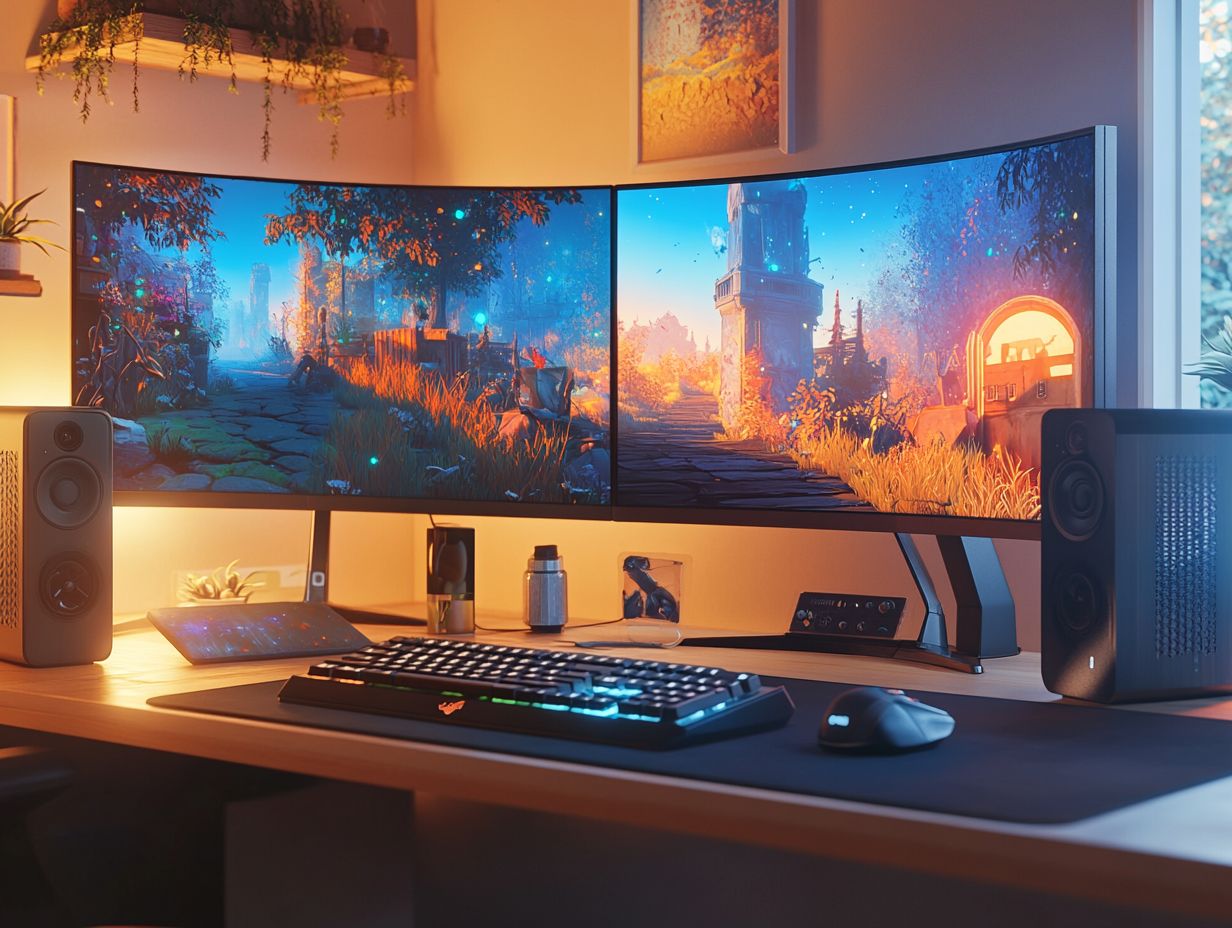
What Are the Must-Have Features of the Best Monitors for Game Design Work?
The best monitors for game design should have high resolution, quick response time, wide range of colors, color accuracy, and an adjustable stand for ergonomic positioning. For those specifically focused on indie games, exploring the best monitors for indie games can ensure a smooth and efficient workflow for all your design tasks.
Are There Any Specific Brands That Are Known for Producing the Best Monitors for Game Design Work?
Many brands offer high-quality monitors for game design, but top contenders include Dell, BenQ, ASUS, and LG. These brands are known for their reliable, professional-grade monitors that cater to game designers’ needs, including the best monitors for streaming and gaming.
How Important Is Color Accuracy for Game Design Work and How Can I Ensure the Monitor Has It?
Color accuracy is crucial for game design as it ensures the colors on the screen match real-life colors. Look for monitors with a high range of colors and various calibration options. You can also use external color calibration tools for precise adjustments.
Should I Prioritize a Larger Size or a Higher Resolution When Choosing the Best Monitor for Game Design Work?
Ideally, you should prioritize both. A larger size provides more workspace for your designs, while higher resolution ensures sharper and more detailed images. If you must choose one, opt for a higher resolution as it’s crucial for game design.
Can I Use a Regular Monitor for Game Design Work or Do I Need a Specific Type?
While you can use a regular monitor for game design, it is not recommended as it may lack the necessary features for this work. Investing in the best monitors for game streaming will yield the best results.
Is It Worth Investing in a Curved Monitor for Game Design Work?
This is a matter of personal preference. Some designers find curved monitors provide a more immersive viewing experience. However, it may not be necessary and could be more expensive. Ultimately, it depends on your budget and personal preferences.

